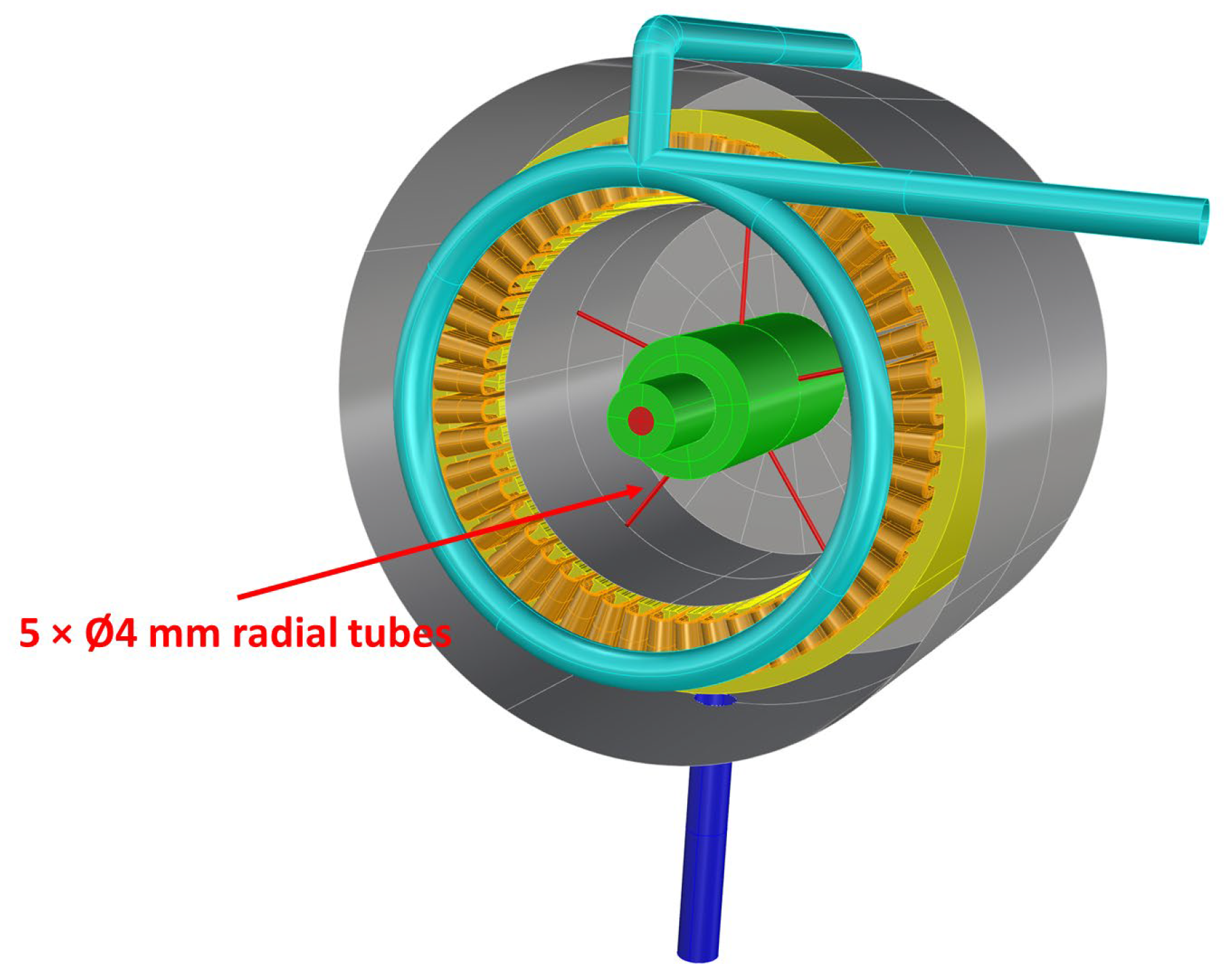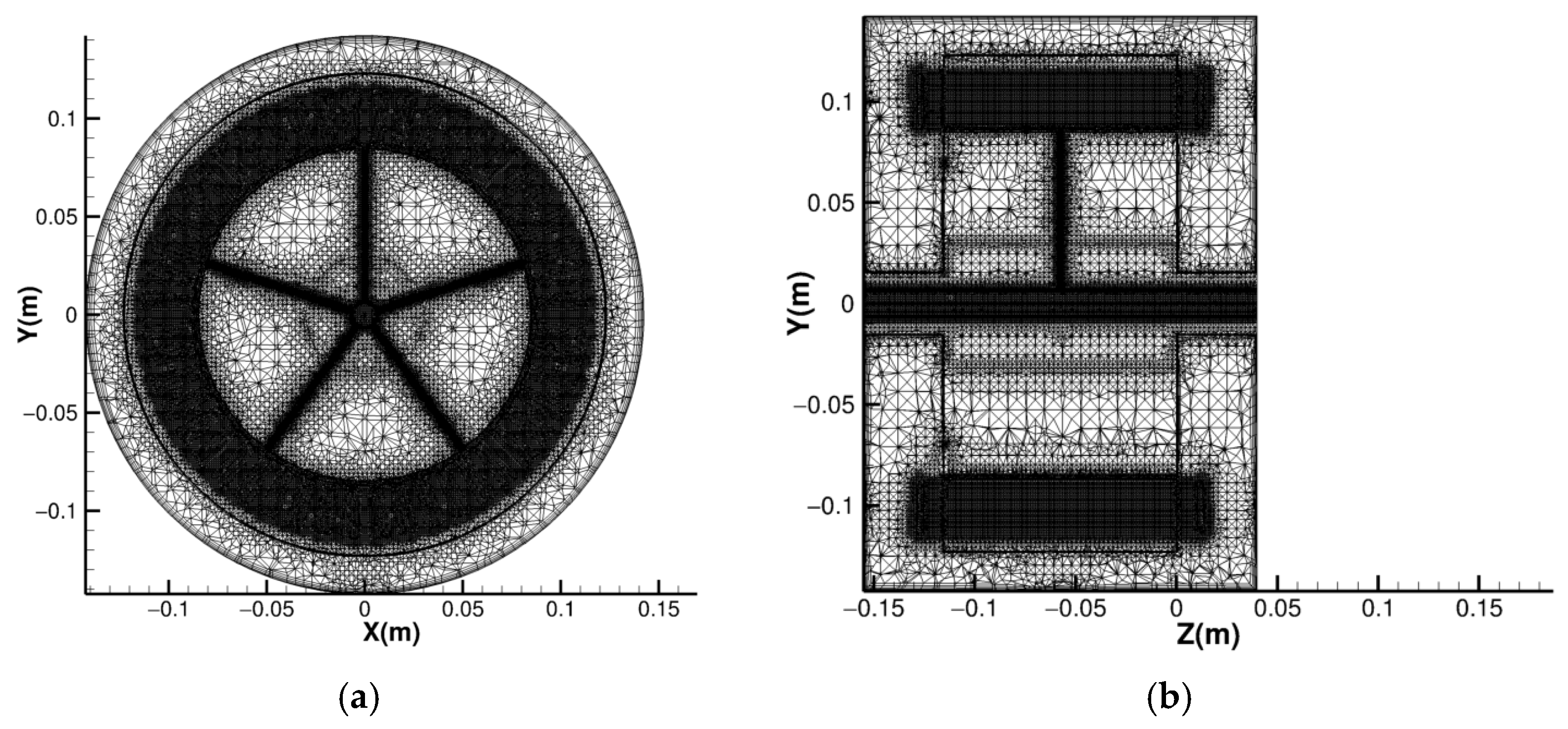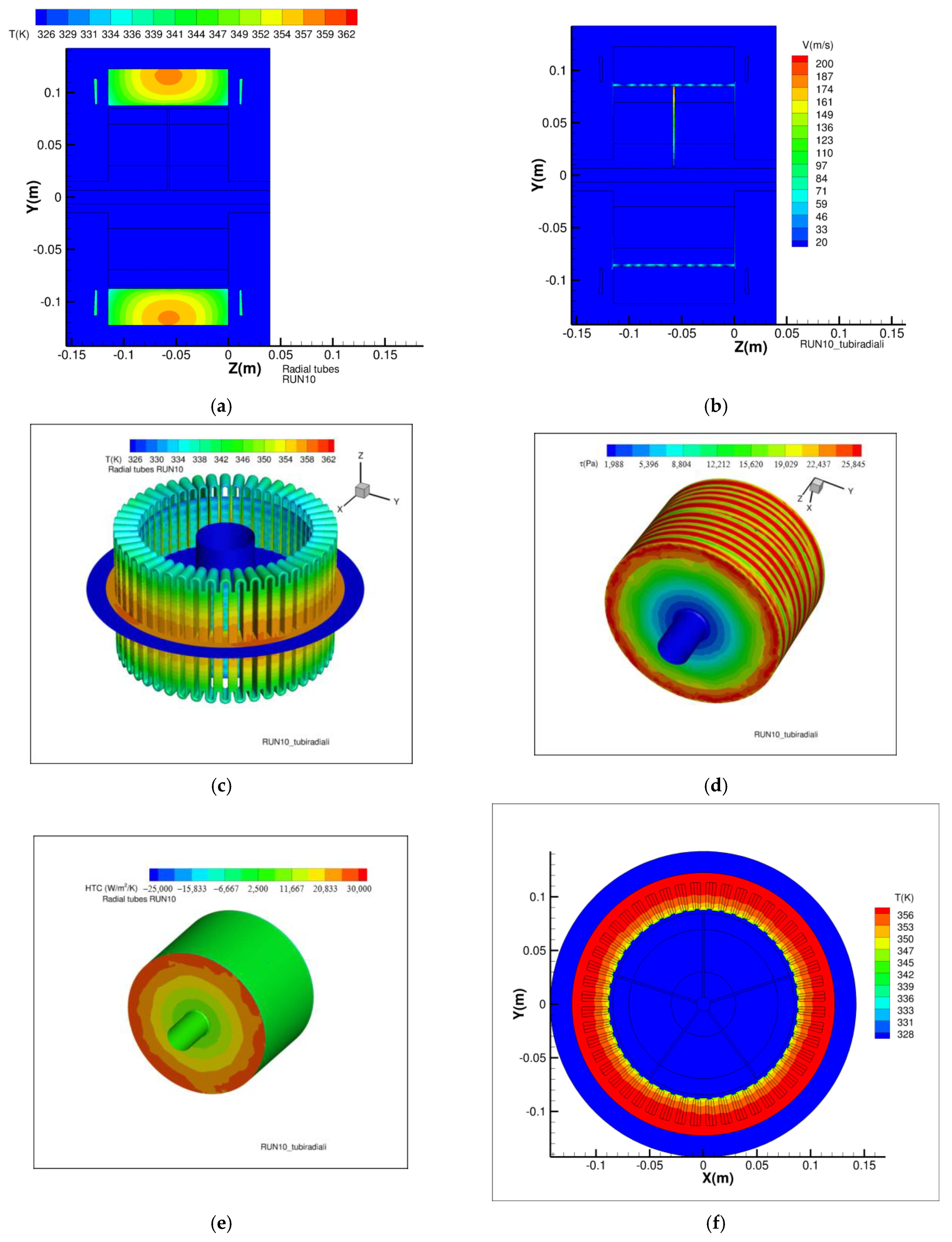Centrifugal Pumping Force in Oil Injection-Based TMS to Cool High-Power Aircraft Electric Motors
Abstract
1. Introduction
2. Background and State of the Art
2.1. A Short Overview of TMSs
2.2. Impinging Jet Technology
2.3. Radial Tubes
3. Objective and Test Case Description
4. Numerical Results
4.1. CFD Setup
- h: sensible enthalpy, [kJ/kgK].
- k: thermal conductivity [W/mK].
- T: temperature.
- Sh: volumetric heat source.
- ρ: density [kg/m3].
4.2. Planned Simulations
4.3. Results and Future Works
5. Conclusions and Remarks
Author Contributions
Funding
Data Availability Statement
Acknowledgments
Conflicts of Interest
References
- United Nations Climate Action. Available online: https://www.un.org/en/climatechange/paris-agreement (accessed on 23 April 2025).
- European Council—Council of the European Union. Paris Agreement on Climate Change. Available online: https://www.consilium.europa.eu/en/policies/paris-agreement-climate/ (accessed on 23 April 2025).
- United Nations Climate Change. Available online: https://unfccc.int/sites/default/files/english_paris_agreement.pdf (accessed on 23 April 2025).
- ICAO Long Term Global Aspirational Goal (LTAG) for International Aviation. Available online: https://www.icao.int/environmental-protection/Pages/LTAG.aspx (accessed on 23 April 2025).
- IAG Flightpath Net Zero. Available online: https://www.iairgroup.com/media/jnmlfzxr/flightpath-net-zero-en-v3.pdf (accessed on 23 April 2025).
- IATA Net Zero Roadmaps. Available online: https://www.iata.org/en/programs/sustainability/roadmaps/ (accessed on 23 April 2025).
- Karpenko, M.; Stosiak, M.; Deptuła, A.; Urbanowicz, K.; Nugaras, J.; Królczyk, G.; Żak, K. Performance evaluation of extruded polystyrene foam for aerospace engineering applications using frequency analyses. Int. J. Adv. Manuf. Technol. 2023, 126, 5515–5526. [Google Scholar] [CrossRef]
- McKinsey&Company. Decarbonizing Aviation: Executing on Net-Zero Goals. Available online: https://www.mckinsey.com/industries/aerospace-and-defense/our-insights/decarbonizing-aviation-executing-on-net-zero-goals (accessed on 23 April 2025).
- ASUENE Blog: ICAO’s Path to Aviation Decarbonization: Strategy, Mechanisms, and Outlook. Available online: https://asuene.com/us/blog/icaos-path-to-aviation-decarbonization-strategy-mechanisms-and-outlook (accessed on 23 April 2025).
- EASA Pro. European Aviation Environmental Report 2025: Turning Goals into Action is Critical for Future of Aviation. Available online: https://www.easa.europa.eu/en/newsroom-and-events/press-releases/european-aviation-environmental-report-2025-turning-goals-action (accessed on 23 April 2025).
- CORDIS—European Commission. ORCHESTRA Project. Available online: https://cordis.europa.eu/project/id/101006771 (accessed on 23 April 2025).
- Di Lorenzo, G.; Romano, D.G.; Carozza, A.; Pagano, A. Cooling of 1 MW Electric Motors through Submerged Oil Impinging Jets for Aeronautical Applications. Aerospace 2024, 11, 585. [Google Scholar] [CrossRef]
- Ministero Dell’università e Della Ricerca. Available online: http://www.ricercainternazionale.mur.gov.it/spaziale/prora.aspx (accessed on 23 April 2025).
- Di Lorenzo, G.; Romano, D.G.; Carozza, A.; Pagano, A. Nanofluids as Coolants to Improve the Thermal Management System of a High-Power Aircraft Electric Motor. Electronics 2025, 14, 911. [Google Scholar] [CrossRef]
- Smithsonian National Air and Space Museum. 1903 Wright Flyer. Available online: https://airandspace.si.edu/collection-objects/1903-wright-flyer/nasm_A19610048000#:~:text=On%20December%2017%2C%201903%2C%20the,at%20Kitty%20Hawk%2C%20North%20Carolina (accessed on 23 April 2025).
- Anderson, J.D. The Airplane: A History of Its Technology; American Institute of Aeronautics and Astronautics: Reston, VA, USA, 2002. [Google Scholar]
- Wikipedia: Aeolipile. Available online: https://en.wikipedia.org/wiki/Aeolipile (accessed on 23 April 2025).
- Espacenet: Whittle Patent. Available online: https://worldwide.espacenet.com/patent/search/family/009723409/publication/GB347206A?q=GB347206A (accessed on 23 April 2025).
- Sir Frank Whittle. The First Patent. Available online: https://frankwhittle.co.uk/the-first-patent/ (accessed on 23 April 2025).
- ThoughtCo. The History of the Jet Engine. Available online: https://www.thoughtco.com/history-of-the-jet-engine-4067905 (accessed on 23 April 2025).
- Google Patents. Available online: https://patents.google.com/patent/US2404334A/en (accessed on 23 April 2025).
- Gunston, B. The Development of Jet and Turbine Aero Engines; Haynes Publishing: Yeovil, UK, 2006. [Google Scholar]
- Mattingly, J.D.; Heiser, W.H.; Boyer, K.M.; Haven, B.A.; Pratt, D.T. Aircraft Engine Design, 3rd ed.; American Institute of Aeronautics and Astronautics, Inc.: Reston, VA, USA, 2018. [Google Scholar]
- Sayyaadi, H.; Mehrabipour, R. Efficiency enhancement of a gas turbine cycle using an optimized tubular recuperative heat exchanger. Energy 2012, 38, 362–375. [Google Scholar] [CrossRef]
- Siddique, M.; Khaled, A.-R.A.; Abdulhafiz, N.I.; Boukhary, A.Y. Recent Advances in Heat Transfer Enhancements: A Review Report. Int. J. Chem. Eng. 2010, 2010, 28. [Google Scholar] [CrossRef]
- Chapman, J.W.; Hasseeb, H.; Schnulo, S. Thermal Management System Design for Electrified Aircraft Propulsion Concepts; NASA/TM-20205011477, March 2021; NASA—Glenn Research Center: Cleveland, OH, USA, 2021. [Google Scholar]
- Alsouda, F.; Bennett, N.S.; Saha, S.C.; Salehi, F.; Islam, M.S. Vapor Compression Cycle: A State-of-the-Art Review on Cycle Improvements, Water and Other Natural Refrigerants. Clean Technol. 2023, 5, 584–608. [Google Scholar] [CrossRef]
- Swain, B.; Memon, S.A.; Achari, A.M.; Mehta, V. A review on analysis and modelling of impinging jets. J. Mech. Eng. Res. Dev. (JMERD) 2019, 42, 43–51. [Google Scholar] [CrossRef]
- THERMOPEDIA. Available online: https://www.thermopedia.com/content/872/ (accessed on 10 July 2024).
- Chen, Q.; Zhang, X.; Zhang, J. Effects of Reynolds and Prandtl Numbers on Heat Transfer Around a Circular Cylinder by the Simplified Thermal Lattice Boltzmann Model. Commun. Comput. Phys. 2015, 17, 937–959. [Google Scholar] [CrossRef]
- Rey, C.; Rosant, J.-M. Reynolds Number and Prandtl Number Influence on the Determination of Isotropic Velocity and Temperature Turbulent Length Scales. In Advances in Turbulence; Comte-Bellot, G., Mathieu, J., Eds.; Springer: Berlin/Heidelberg, Germany, 1987; pp. 209–214. [Google Scholar]
- Shukla, A.K.; Dewan, A. Flow and thermal characteristics of jet impingement: Comprehensive review. Int. J. Heat Technol. 2017, 35, 153–166. [Google Scholar] [CrossRef]
- Darwish, A.M.; El-Kersh, A.-F.; El-Sheikh, M.N.; El-Moghazy, I.M. A Review on Nanofluid Impingement Jet Heat Transfer. Int. J. Nanotechnol. Allied Sci. 2017, 1, 1–15. [Google Scholar]
- Fitzgerald, J.A.; Garimella, S.V. A study of the flow field or a confined and submerged impinging jet. Int. J. Heat Mass Transfer. 1998, 41, 1025–1034. [Google Scholar] [CrossRef]
- Lupton, T.L.; Murray, D.B.; Robinson, A.J. The Effect of Varying Confinement Levels on the Heat Transfer to a Miniature Impinging Air Jet; Eurotherm: Eindhoven, The Netherlands, 2008. [Google Scholar]
- Hogan, B.E. Convective Heat Transfer in Rotating, Circular Channels. Bachelor of Science in Engineering as Recommended by the Department of Mechanical Engineering; Massachusetts Institute of Technology: Cambridge, MA, USA, 2002. [Google Scholar]
- Abdulrahman, G.A.Q.; Alharbi, S.M. Laminar and turbulence forced heat transfer convection correlations inside tubes. A review. arXiv 2024, arXiv:2401.02998v1. [Google Scholar] [CrossRef]
- Zhang, Z.-C.; Song, Q.; Bilal, A. Innovative Design of the Cooling Topologies for Electric Vehicle Motors. IOP Conf. Ser. Mater. Sci. Eng. 2019, 533, 012021. [Google Scholar]













| Boundary Conditions | Zones |
|---|---|
| Mass flow inlet | Inlet holes |
| Outflow | Exit hole |
| Moving wall | External rotor surfaces |
| Wall/no slip | The remainder |
| Constant heat flux | Teeth |
| Uniform heat power source (W/m3) | Stator yoke, end-winding, copper |
| Id. Case | Inlet Diameter [mm] | Oil Injection Speed [m/s] |
|---|---|---|
| Run 4 | 2 | 0.5 |
| Run 5 | 2 | 1 |
| Run 10 | 4 | 1 |
| Run/Output | RUN4 | RUN4-TR | RUN5 | RUN5-TR | RUN10 | RUN10-TR |
|---|---|---|---|---|---|---|
| Vout [m/s] | −0.568 | −0.95 | −1.15 | −1.05 | −4.49 | −3.70 |
| Vout_theor [m/s] | −0.57 | −1.00 | −1.15 | −1.15 | −4.52 | −4.00 |
| Tout, ave [K] | 372 | 328 | 325 | 327 | 331 | 325 |
| WSS, ave [Pa] | 14,143 | 10,023 | 17,293 | 10,039 | 17,585 | 15,983 |
| WSS, max [Pa] | 33,517 | 30,196 | 35,718 | 34,442 | 39,416 | 41,500 |
| Tmax (stator) [K] | 402.3 | 363.6 | 379.8 | 363.0 | 360.8 | 358.5 |
| Tave (stator) [K] | 395.0 | 356.0 | 372.5 | 355.4 | 354.1 | 350.8 |
| Tmax (EW) [K] | 402.3 | 363.6 | 379.8 | 363.0 | 360.8 | 358.2 |
| Tave (EW) [K] | 392.7 | 353.3 | 370.2 | 352.7 | 351.8 | 347.7 |
| Tmax (Tooth) [K] | 402.3 | 357.8 | 379.8 | 357.5 | 360.8 | 351.8 |
| Tave (Tooth) [K] | 385.6 | 343.6 | 362.9 | 343.1 | 344.6 | 337.3 |
| Tmax (Rotor) [K] | 377.3 | 332.8 | 353.8 | 332.9 | 336.7 | 325.5 |
| Tave (Rotor) [K] | 375.8 | 330.2 | 352.3 | 329.6 | 334.7 | 325.2 |
| Tmax [K] | 402.3 | 363.6 | 379.8 | 363.0 | 360.8 | 358.5 |
| ΔTMax (%) | - | 1.55 | - | 1.39 | - | 0.13 |
Disclaimer/Publisher’s Note: The statements, opinions and data contained in all publications are solely those of the individual author(s) and contributor(s) and not of MDPI and/or the editor(s). MDPI and/or the editor(s) disclaim responsibility for any injury to people or property resulting from any ideas, methods, instructions or products referred to in the content. |
© 2025 by the authors. Licensee MDPI, Basel, Switzerland. This article is an open access article distributed under the terms and conditions of the Creative Commons Attribution (CC BY) license (https://creativecommons.org/licenses/by/4.0/).
Share and Cite
Di Lorenzo, G.; Romano, D.G.; Carozza, A.; Pagano, A. Centrifugal Pumping Force in Oil Injection-Based TMS to Cool High-Power Aircraft Electric Motors. Energies 2025, 18, 3390. https://doi.org/10.3390/en18133390
Di Lorenzo G, Romano DG, Carozza A, Pagano A. Centrifugal Pumping Force in Oil Injection-Based TMS to Cool High-Power Aircraft Electric Motors. Energies. 2025; 18(13):3390. https://doi.org/10.3390/en18133390
Chicago/Turabian StyleDi Lorenzo, Giuseppe, Diego Giuseppe Romano, Antonio Carozza, and Antonio Pagano. 2025. "Centrifugal Pumping Force in Oil Injection-Based TMS to Cool High-Power Aircraft Electric Motors" Energies 18, no. 13: 3390. https://doi.org/10.3390/en18133390
APA StyleDi Lorenzo, G., Romano, D. G., Carozza, A., & Pagano, A. (2025). Centrifugal Pumping Force in Oil Injection-Based TMS to Cool High-Power Aircraft Electric Motors. Energies, 18(13), 3390. https://doi.org/10.3390/en18133390






